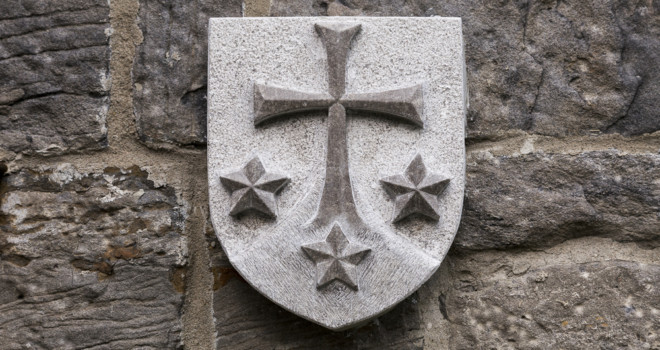This is the second article meant to help laity develop good spiritual practices that aid in the journey toward holiness. The basic premise of this series is that the laity can and should learn to incorporate the wisdom and spiritual practices of some of the great consecrated religious orders throughout Church history. This time, we’re focused on Carmelite spirituality. Along with the Carmelites, we celebrate the feast day of Our Lady of Mount Carmel on July 16 each year.
The Rule of St. Albert Avogardo, by which Carmelite life is governed, says: “whatever his station or the kind of religious observance he has chosen, should live a life in allegiance to Jesus Christ—how, pure in heart and stout in conscience, he must be unswerving in the service of the Master” (§2; emphasis added). Here we are reminded that this lifestyle is, first and foremost, in answer to the universal call to holiness. Allegiance to Jesus, “pure in heart and stout in conscience,” can be lived by any of us, not just monks and religious sisters.
According to the Carmelite mission statement, a person develops a pure heart and stout conscience by seeking the face of the living God through a commitment to contemplation. Carmelites are guided by a spirit of mysticism, finding God’s face in every possible place. The laity must know that God’s face can be found everywhere in the midst of daily life. We can ponder his goodness and power, and draw ever closer to him in every situation.
Carmelite history and devotion give us two specific places to seek God’s face. The first is in their devotion to the story of the Old Testament. Carmelites feel themselves connected deeply to the prophet Elijah, who was anointed for his mission on Mount Carmel in the Holy Land. Among the prophets of the Old Testament, Elijah stands paramount as one who brings us back into the vision of God’s holy face. So, we laity can read the stories and messages of the Old Testament prophets to see the face of God more clearly in our own lives. That’s why, for example, we should pay attention a little more closely to the first reading at Sunday Mass. There’s a message there for us, too.
Related to the devotion to the Old Testament is the Carmelite devotion to Our Lady. The original Carmelite monks erected a chapel to her in the earliest days of the order, and they have taken her as patroness ever since. Along with those things, Carmelites seek to ponder the reality of Jesus in their hearts in a Marian way (cf. Lk. 2:51), daily and over long periods of time. Growing in our own devotion to Mary will help us to live more like Carmelites in the modern world.
One specific way that many Catholics consecrate themselves to Jesus and the Blessed Mother is enrollment in the Brown Scapular. This involves wearing a brown, rectangular piece of wool (usually with some other images and medals) and observing a few other requirements. Information is easily available on the internet, and any Catholic priest can enroll a person in the Brown Scapular. The Congregation for Divine Worship tells us that wearing the brown scapular is “an external sign of the filial relationship established between the Blessed Virgin Mary, Mother and Queen of Mount Carmel, and the faithful who entrust themselves totally to her protection, who have recourse to her maternal intercession, who are mindful of the primacy of the spiritual life and the need for prayer,” ( Who among us does not need to be more mindful of prayer and the importance of the spiritual life?
Beyond enrolling in the Brown Scapular, the Carmelite tradition offers a plethora of history’s best writings on prayer and meditation. Laity will do well to incorporate some of these texts into their ongoing prayer lives. Some of the best-known of these are The Way of Perfection and Interior Castle, by St. Teresa of Avila; The Ascent of Mount Carmel by St. John of the Cross; and Divine Intimacy, by Fr. Gabriel of St. Mary Magdalene. For the laity, though, the best is a book titled The Practice of the Presence of God, by Brother Lawrence. It is a tiny little text that can help every person connect with the living God at any moment of the day, in the midst of mundane life.
All of these devotional practices, from scapulars to spiritual reading, are meant to bring us to a deep and abiding connection with God. They are meant to bring us to contemplation, which is a Carmelite specialty. In the midst of life’s busy-ness, each and every lay person must know what brings him or her to that robust and fulfilling relationship with the divine.
One place I have found particularly ripe for such a connection to God is in front of the Blessed Sacrament in Eucharistic Adoration. Over years, I have been blessed to visit Adoration chapels frequently, sometimes five or six days each week. In each of these visits (usually called a holy hour because it lasts 60 minutes) there is time for spiritual reading. But, the best part is to put down the books and the Rosary and simply let God fill me with His life for whatever amount of time, and in whatever way He desires. Carmelites would be happy to hear of anyone taking up such this practice.
These simple practices—wearing the Brown Scapular, regular spiritual reading, devotions to the prophets and to Our Lady, and finding a quiet spot for fruitful contemplation—will bring anyone closer to God, which will then cultivate zeal for answering the call to holiness. Each of us, the Church, and the world will benefit from growing a little more fully in Carmelite spirituality.












